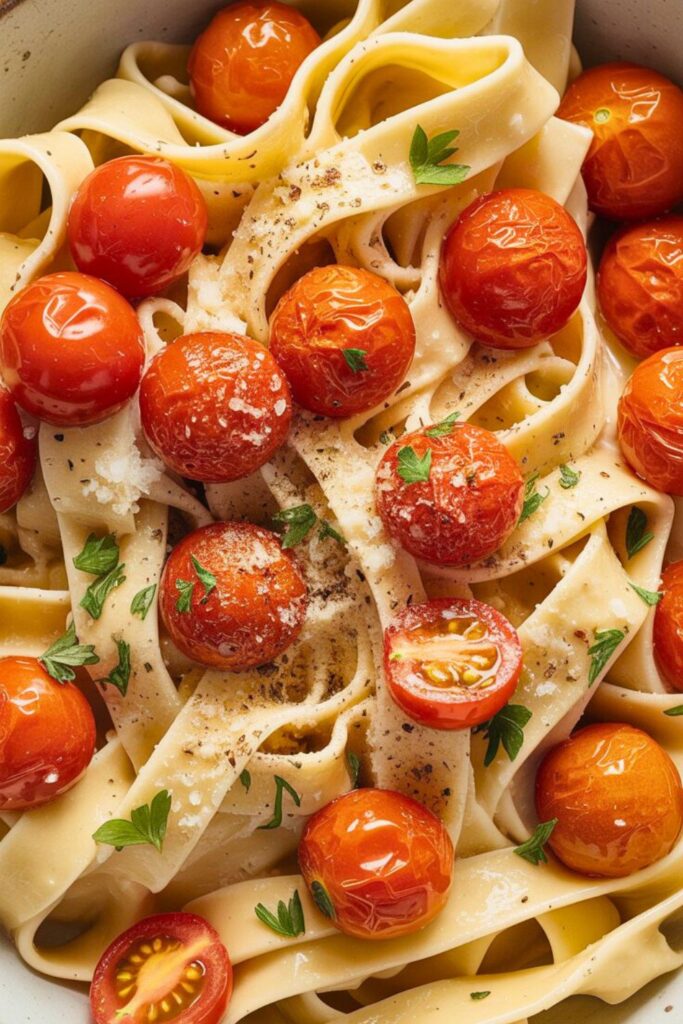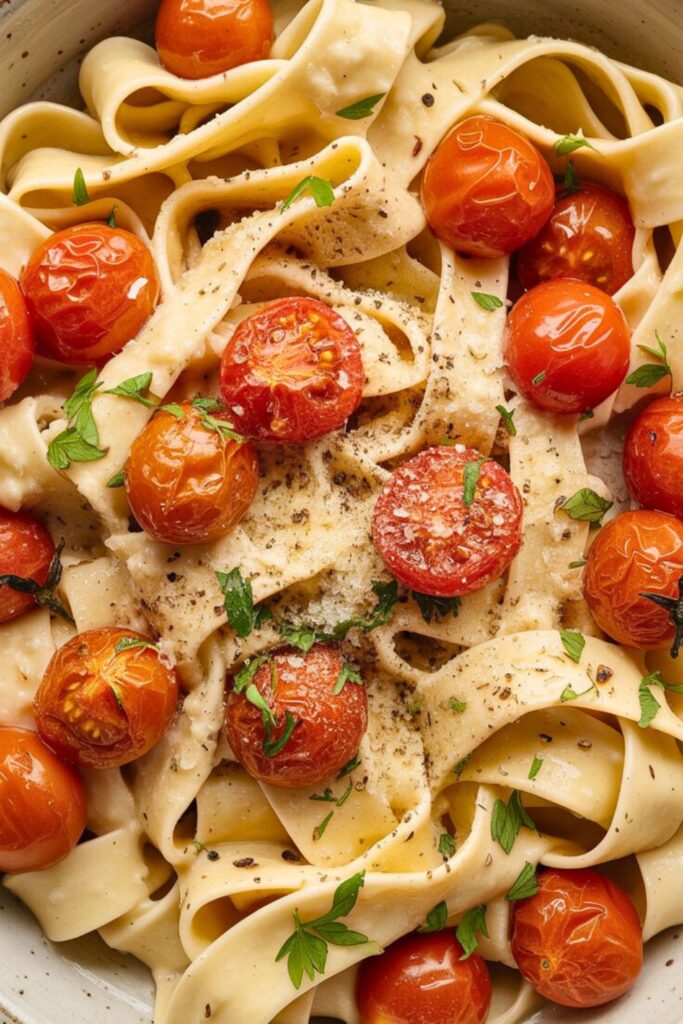Listen – I’ve watched too many home cooks panic over ricotta. They treat it like it’s gonna explode if they breathe on it wrong. Meanwhile, their Blissful tomato ricotta pasta turns into chunky disaster soup while they’re tiptoeing around their own kitchen.
Here’s what nobody’s telling you: ricotta wants to be in this dish. It’s literally designed for moments like this, when you need something creamy and luxurious but don’t have time for complicated sauce gymnastics. This tomato ricotta pasta recipe isn’t just another weeknight dinner – it’s your ticket to understanding how cheese actually works.
The Italians figured this out centuries ago, but somehow we got obsessed with heavy cream and forgot the basics. Ricotta means “recooked,” and that’s exactly what happens when you do this right. The proteins transform into silk. The flavors marry into something that tastes like it took hours but comes together in twenty minutes.
What makes this dish absolutely essential? It teaches you the foundation of cheese-based sauces without the drama. Master this technique, and you’ll never fear ricotta again.
Why This Tomato Ricotta Pasta Recipe Changes Everything

Here’s the thing about ricotta – it’s not just cheese. It’s an emulsifier waiting to happen. When you treat it right, those proteins grab onto everything around them and create the most luxurious coating for pasta you’ve ever experienced.
This tomato ricotta pasta breaks every rule you think you know. We skip the traditional soffritto. We don’t sweat onions for twenty minutes. Instead, we let garlic and tomatoes build flavor while ricotta works its magic in the background.
The technique is pure genius disguised as simplicity. You’re creating a warm emulsion, like making mayonnaise but with cheese instead of eggs. Hot pasta water becomes your secret weapon, helping everything bind together perfectly.
Most people mess this up because they treat ricotta like cream. It’s not. Ricotta has structure, personality, and opinions about temperature. Respect those opinions, and it’ll give you restaurant-quality results every single time.
Essential Ingredients for Perfect Tomato Ricotta Pasta
Let’s build this masterpiece ingredient by ingredient. Order matters because timing controls everything when you’re working with cheese proteins.
Fresh ricotta cheese (1 cup) – your star player needs to be whole milk and heavy in the container. Those watery store brands will betray you. Look for ricotta that feels substantial and creamy.
Canned San Marzano tomatoes (28 oz can) – crush these by hand because knives create wrong textures. The rough edges grab sauce better. Can’t find San Marzanos? Any high-quality whole tomatoes work fine.
Garlic (4 cloves, sliced thin) – we slice instead of mince because we want golden, crispy edges that add texture and concentrated flavor to every bite.
Fresh basil (1/2 cup, torn by hand) – dried basil here is like using black and white photos when you have color available. Tear it to release essential oils.
Long pasta (1 lb) – spaghetti, linguine, or bucatini give ricotta maximum surface area to cling. Short pasta doesn’t create the right sauce-to-pasta ratio.
Quality olive oil (1/4 cup) – this isn’t cooking oil time. Use something that tastes like sunshine and makes you happy.
Pecorino Romano (1/2 cup, grated) – sharper than Parmesan, saltier than Parmigiano-Reggiano. It cuts through richness without competing for attention.
Smart Ingredient Swaps That Actually Work
Life happens. Ingredients disappear. Here’s how to adapt without losing the soul of this dish.
No fresh ricotta? Blend whole milk cottage cheese until smooth. The texture changes slightly, but creamy richness remains intact.
Lactose intolerant? Cashew ricotta or silken tofu blended with lemon juice substitute beautifully. You lose some tang but gain digestibility.
Can’t find good canned tomatoes? Fresh works if they’re in season and you blanch them first. Out of season? Stick with canned – they taste better than sad winter tomatoes.
Choose ricotta by reading ingredient lists. Milk, vinegar or citric acid, salt. That’s it. Stabilizers and gums mean keep looking for better options.
Step-by-Step Tomato Ricotta Pasta Magic
Start with pasta water – really start there first. Fill your biggest pot and get it boiling while you prep everything else. Salt it heavily. This isn’t just cooking liquid; it becomes part of your sauce foundation.
Heat olive oil in your largest skillet over medium heat. We want gentle sizzling, not aggressive frying sounds. Add sliced garlic and let it swim around until edges turn golden and your kitchen smells incredible.
Timing becomes crucial here. Add crushed tomatoes right when garlic hits perfect golden-brown. Cold tomatoes stop garlic from overcooking while creating beautiful flavor layers. Season with salt and simmer while pasta cooks.
The ricotta trick nobody teaches: remove it from the fridge twenty minutes before cooking. Cold ricotta seizes when it hits hot pasta. Room temperature ricotta melts like silk.
Drop pasta into boiling water eight minutes before package directions suggest. We want serious al dente because it finishes cooking in the sauce.
While pasta bubbles, grab a large bowl and add room temperature ricotta. This staging area is where magic happens between ingredients.
When pasta hits perfect al dente bite, reserve two full cups of pasta water. You think you won’t need it all, but you absolutely will.
Here’s the technique that separates good from great: add half a cup of starchy pasta water to ricotta and whisk aggressively. You’re creating ricotta cream that binds everything without breaking.
Drain pasta and immediately toss into simmering tomato base. Add ricotta mixture and move everything with tongs. Pasta absorbs liquid fast, so add more pasta water gradually until you achieve glossy, clingy sauce coating.
Off heat, add torn basil and half the pecorino. Toss everything once more and taste for proper seasoning balance.
Common Tomato Ricotta Pasta Mistakes That Ruin Everything
Mistake number one: adding cold ricotta directly to hot pasta creates chunky, broken sauce that looks like cottage cheese disaster.
The temperature trap: keeping heat too high once you add ricotta breaks proteins and destroys silky texture forever.
Pasta water neglect: not saving enough starchy cooking liquid eliminates your sauce-rescue insurance policy. Without it, you can’t fix anything.
Pro tip from my Italian neighbor: if sauce looks too thick, add pasta water one tablespoon at a time while tossing. Too thin? Add more grated cheese and keep pasta moving off heat.
The Science Behind This Blissful Tomato Ricotta Pasta

Pure food science magic happens here. Ricotta contains casein and whey proteins that behave differently when heated. Casein proteins want to clump, but starchy pasta water creates protective barriers keeping everything smooth.
Tomato acid plays a crucial role too. It brightens rich ricotta while helping flavors marry together. Too much acid curdles cheese. Too little makes everything taste flat and boring.
Temperature control defines this entire recipe. You’re working within specific ranges where ricotta stays creamy but doesn’t break. Think tempering chocolate – there’s a sweet spot where everything comes together perfectly.
Starch from properly cooked pasta water contains amylose and amylopectin acting like natural emulsifiers. They bind ricotta fat with water-based tomato sauce, creating glossy, restaurant-quality finishes.
Tools That Make the Difference
Heavy-bottomed skillets change everything about this recipe. Thin pans create hot spots that break ricotta faster than you can say disaster.
Good tongs are non-negotiable for keeping pasta moving and ensuring even sauce distribution throughout. Forks and spoons just don’t work properly.
Fine-mesh strainers for pasta water reserve ensure you’re not adding random pasta bits to carefully crafted sauces.
Wide pasta pots matter too. You need space for pasta to move freely. Crowded pasta cooks unevenly and releases less beneficial starch.
Making Beautiful Restaurant-Worthy Tomato Ricotta Pasta
Presentation starts with pasta itself. Use tongs to create neat nests in warmed bowl centers. Sauce should cling to every strand without pooling at bottoms.
Finishing touches that matter: generous freshly cracked black pepper, quality olive oil drizzles, and remaining basil leaves scattered on top. Each element adds flavor and visual appeal simultaneously.
For photos that make friends jealous, natural light works best. Creamy ricotta and bright red tomatoes create gorgeous color contrast against white or dark bowls.
Perfect pairings that complete meals: simple arugula salads with lemon vinaigrette cut through richness beautifully. Crisp white wines like Pinot Grigio complement without competing. Crusty bread for sopping sauce is basically mandatory.
Feeling fancy? Add torn mozzarella pieces at the very end for amazing cheese pulls that look incredible and taste even better.
Bringing Your Tomato Ricotta Pasta Together

This tomato ricotta pasta represents everything I love about Italian cooking principles. It’s simple enough for Tuesday nights but special enough for important company. Ingredients are accessible, but technique teaches valuable lessons about protein and starch interactions.
Beauty lies in adaptability once you master basics. Add spinach for complete meals. Toss in Italian sausage for Sunday dinners. Add pine nuts for restaurant-quality results from your own kitchen.
What makes this tomato ricotta pasta recipe worth memorizing? It changes your relationship with ricotta forever. You’ll start seeing possibilities everywhere – in soups, on pizza, mixed with roasted vegetables. It’s not just pasta sauce; it’s a fundamental technique.
The most important takeaway? Trust the process completely. Let ricotta reach room temperature. Save more pasta water than you think necessary. Keep heat gentle once everything comes together. These details create the difference between good pasta and pasta people remember forever.
Frequently Asked Questions About Tomato Ricotta Pasta
Can I make this tomato ricotta pasta ahead of time?
This dish shines when served immediately, but life requires flexibility sometimes. Make the sauce base – tomatoes, garlic, oil – up to two days ahead and refrigerate. Don’t add ricotta until serving time. Ricotta-based sauces don’t reheat well because proteins break down and get grainy. If you must prep ahead, undercook pasta slightly and add extra pasta water when reheating gently.
Why does my ricotta look curdled in the sauce?
Temperature shock usually causes this problem. Cold ricotta hitting hot pasta breaks protein structure faster than you can fix it. Always bring ricotta to room temperature first, then temper with warm pasta water before adding to hot pasta. If already curdled, try whisking more hot pasta water off heat – sometimes you can save it, but prevention beats fixing.
What’s the best pasta shape for this recipe?
Long, thin pasta works best because it gives ricotta maximum surface area for clinging. Spaghetti is classic, but linguine and bucatini are phenomenal too. Avoid short pasta like penne or rigatoni – sauce doesn’t coat properly and you lose silky, connected texture that makes this dish special. Fresh pasta works beautifully, but good dried pasta works perfectly fine.
Can I freeze leftover tomato ricotta pasta?
This isn’t a great freezing candidate honestly. Ricotta-based sauces separate when frozen and thawed, leaving watery, grainy messes that don’t resemble original dishes. Instead, freeze just tomato base without ricotta, then make fresh ricotta sauce when ready to eat. The whole dish comes together quickly enough that making it fresh each time makes more sense.
How do I know when sauce consistency is perfect?
Perfect consistency coats pasta like silk without being gloppy or watery. When you lift pasta with tongs, sauce should cling to every strand and look glossy under kitchen lights. Too thick? Add pasta water one tablespoon at a time while tossing. Too thin? Add more grated cheese and keep pasta moving off heat until it tightens up properly. Sauce continues thickening as it cools, so err toward slightly loose rather than too thick.

Swiftly Captions by Tina Smith — Quick, flavorful food recipes made simple, bringing fresh inspiration to your kitchen every day






